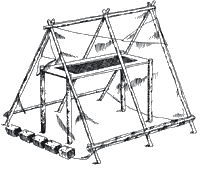Mangoes
Good quality, half-ripe large mangoes which do not contain too many fibres will give the best results. The mangoes are first washed, peeled and cut into thin slices (6–8 mm thick) with a stainless steel knife. Soak the mangoes in a bowl containing:
- 1 litre of boiling water
- 7–800 g (5 small teacups) of sugar
- 3 g (1 heaped teaspoon or soda bottle top) of potassium metabisulphite (a preservative which can be bought in chemists)
- 2 large spoons of lemon juice.
After 18 hours drain the slices and place them in a sun drier on trays which are first coated with glycerine to stop the mango slices from sticking to the metal. When the slices are really well dried, they should be stored in plastic bags or jars, which are sealed tightly to prevent air or damp from entering. These mango slices will keep for up to a year.
This method can be used to dry other juicy fruits – for example: pineapple, papaya, figs, jack fruit.
Tomatoes and onions
Tomatoes, onions and herbs do not need any kind of treatment or preservative before drying. Tomatoes should be cut in half and the seeds removed before cutting into thin slices. Store the dried onion or tomato in sealed plastic bags or jars. They are delicious when added to stews and soups and should keep for up to a year.
Other vegetables
Other vegetables such as okra, cabbages, yams, carrots, green beans and peppers should be cut into thin slices and then dipped for three minutes into a pan containing:
- 1 litre of boiling water
- 50 g (2 large spoons) of salt
- 3 g of potassium metabisulphite.
Place the vegetables in a clean cloth or in a wire mesh to dip them easily into the boiling water. This will keep their colour better and preserve their taste. Drain the vegetables and then dry on trays under a sun drier. Again, store in sealed plastic bags or jars for up to a year.
Using the sun’s energy
In Footsteps 16 we showed how to make a solar cooker. This cooker and a similar version (shown on page 9 of this issue) can also be used to preserve fruit and vegetables in addition to cooking meals.
Fresh fruit or vegetables are peeled and sliced. Place in clean plastic bags which feel crisp (not smooth) when rubbed between the fingers. A little sugar can be added to fruit. No water is needed for leafy vegetables. The bags are placed in a pan of water in the solar cooker for one or two hours with the ends of the bags hanging out of the pot. The bags are then tightly sealed without letting any air enter. Food will be preserved and kept sterile if the bags are not opened.
Delicious crystallised fruit can be produced in solar cookers. Fruit such as oranges, lemons or grapefruits are cut up into small pieces. About the same weight of sugar as fruit is added with a little clean water. The fruit and sugar is cooked for several hours in a glass or metal pot, with an occasional stir to make sure the sugar has dissolved. The crystallised fruit can be sun dried as above so it will keep for up to a year, or used immediately to produce cakes. Young leaves of prickly pear cactus can also be used in this way (after removing the prickles) to produce crystallised fruit. The sweet juice left over can be used for a fruit drink by adding fresh lemon juice and water to dilute.
With thanks to UNIFEM, FAO and Anna Pearce of Box Aid for permission to include information and illustrations.










